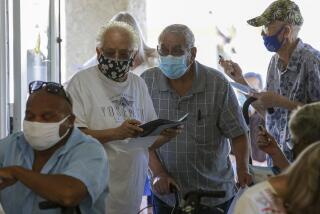The West Leads U.S. in HMO Membership
- Share via
WASHINGTON — More Americans are enrolling in health maintenance organizations, with 18% of the population--46 million people--now counting themselves as members, according to an annual report on the nation’s health.
Managed-care organizations have the greatest impact in the West, where 29% of the population is enrolled, and the least in the South, where only 11% are HMO members, according to the 20th annual report on health in the U.S. by the Department of Health and Human Services.
Managed-care companies such as WellPoint Health Networks Inc. and PacifiCare Health Systems Inc. have posted higher quarterly earnings thanks to strong gains in enrollment, particularly in California. The growing number of members--up 39% for WellPoint and 28% for PacifiCare during the first quarter--also helped the companies increase their profit margins.
Meanwhile, the number of Americans with any type of private health insurance declined to 70% in 1994 from 77% five years earlier.
The percentage of people covered by Medicaid, the government’s health insurance program for the poor and disabled, rose to 10% from 6% during the same period.
The report comes as Congress is working on a bill aimed at expanding access to health coverage, allowing workers to keep their insurance when they change jobs and reducing insurance companies’ ability to deny coverage for preexisting conditions.
Senate Majority Leader Trent Lott (R-Miss.) said he wants to complete work on the legislation, which includes incentives for people to open savings accounts to pay medical bills, before Congress adjourns for the Fourth of July holiday.
Separately, HHS reported that American women live an average of 79 years, almost seven years longer than do American men. Heart disease is the leading cause of death for women, although cancer, particularly lung cancer, claims more women between the ages of 25 and 74.
“We need to pay more attention to women’s health issues,” said HHS Secretary Donna Shalala. “Much of this report contains good news for women, but these statistics also tell us that there remains a great deal of work ahead.”
Women are getting fatter, with one in three now considered overweight, compared with one in four a decade ago, the report says. And while smoking rates are on the decline for both men and women, women are kicking the habit at a slower pace.
Because women also are more likely to suffer from nonfatal chronic conditions, including arthritis and osteoporosis, middle-aged and older women are more likely to have trouble taking care of themselves and their homes, the report says.
More to Read
Inside the business of entertainment
The Wide Shot brings you news, analysis and insights on everything from streaming wars to production — and what it all means for the future.
You may occasionally receive promotional content from the Los Angeles Times.










